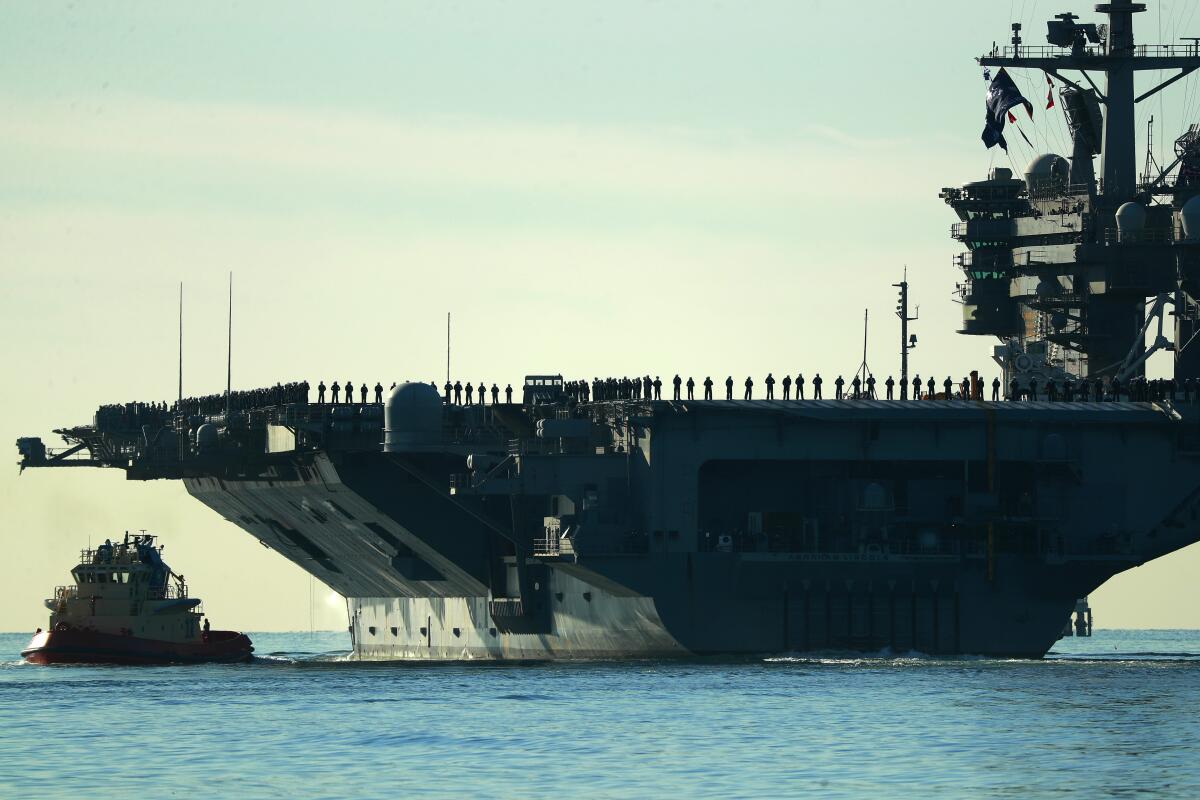In a historic first, U.S. aircraft carrier deploys from San Diego with a woman in command

- Share via
CORONADO, Calif. — An aircraft carrier is steaming toward the western Pacific on a routine deployment, and for the first time in Navy history, it’s doing so with a female captain in charge.
For the nuclear-powered aircraft carrier Abraham Lincoln, which left its berth at Naval Air Station North Island in San Diego Bay on Monday morning, the deployment marks the culmination of nine months of training and work-ups. It’s also the first carrier deployment for a Marine Corps F-35C fighter squadron.
Capt. Amy Bauernschmidt took command of the ship in August, becoming the first woman to command a Navy aircraft carrier.
The carrier’s deployment comes amid increasingly hostile rhetoric between China and Taiwan. Rear Adm. Jeffrey Anderson, the Lincoln carrier strike group commander, didn’t comment specifically on the matter during a news conference Monday but said the strike group is ready to accomplish its mission, whatever that might be.
“We’re trained and certified for global deployment,” Anderson said. “Our mission is to provide combat capability and ready naval forces so that we can work alongside our allies and partners to be able to deter aggression and also counter malign influence.”
Bauernschmidt said that her crew performed exceptionally during deployment work-ups and that she was humbled to be entrusted with their safety.
“This is an amazing day,” she said. “They are going to do exceptional work out there, and I just can’t wait to watch them succeed.”
Five sailors were killed during those work-ups in September when their helicopter crashed into the carrier’s flight deck and tumbled into the sea. Bauernschmidt, who came up through the ranks flying helicopters, had been in command for 12 days when the crash occurred. She offered condolences to the families of those killed and talked about the effect the crash had on the crew.
“It is always a tough experience and no one is prepared for something like that — everyone deals with it in their own way,” she said. “It was a tough day that none of us will ever forget.”
The investigation into the crash is ongoing, Anderson said. He declined to comment on possible causes. A preliminary report said the helicopter experienced side-to-side vibrations while on the flight deck before the crash.
The ship’s departure also coincides with soaring coronavirus case numbers. However, unlike previous carrier deployments, the crew of the Lincoln, its air wing and the crews of other ships in the battle group are 100% vaccinated, Anderson said. The crew did not have to quarantine ahead of the ship’s departure, and as the strike group deploys, they leave with known positive cases among them.
“We do have some positive cases within the strike group,” Anderson said. “But … we’re extremely confident that we can safely and effectively execute our mission.”
All active-duty sailors and Marines were required to be fully vaccinated against COVID-19 by the end of November. Marines who refused the vaccine are already being booted from the Corps, and the Navy is preparing to do the same with its noncompliant sailors.
Marine Fighter Attack Squadron 314 becomes the first Marine F-35C squadron to deploy on an aircraft carrier. The Marine Corps Air Station Miramar-based squadron is only the second F-35C squadron to do so; Navy Fighter Attack Squadron 147 deployed on the San Diego-based carrier Carl Vinson in August.
More to Read
Sign up for Essential California
The most important California stories and recommendations in your inbox every morning.
You may occasionally receive promotional content from the Los Angeles Times.














